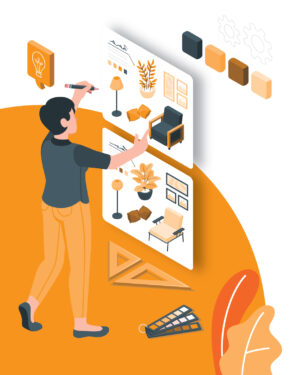Frequently Asked Questions
- Show All
- Bedroom Decors
- Commercial Concepts
- Foyer Design
- Home
- Home Office Design
- Living Room
- Modular Kitchen
- Wardrobe Elements
1. What kind of furniture is essential for a home office?
Essential furniture for a home office includes a comfortable desk and chair, storage spaces like shelves, cabinets, or drawers, and adequate lighting. Ergonomic furniture is crucial for long-term comfort and productivity.
2. What are some tips for organizing my home office space?
Organize your home office by decluttering regularly, using storage solutions to keep things tidy, and setting up a system for managing paperwork and supplies. Keep frequently used items within easy reach.
3. What kind of lighting is best for a home office?
Natural light is ideal, but if that's not possible, use a combination of ambient and task lighting. Avoid harsh overhead lights and opt for adjustable desk lamps to reduce eye strain.
4. Do I need to consult with a professional designer for my home office?
Consulting with a professional designer is optional, but it can be beneficial, especially if you have unique requirements or a larger budget. Designers can provide expert advice and help create a tailored workspace.
4 – Is it necessary for me to seek out an interior designer for my venture?
Contracting an interior designer may be advantageous, particularly for complicated or large-scale projects. They contribute knowledge, innovation, and industry contacts. You can, however, handle the design process yourself for smaller projects or if you have a clear concept.
3 – What are some sustainable interior design customs?
Sustainable and ecologically responsible decisions are the emphasis of eco-friendly interior design. This includes the use of recycled materials, low VOC (volatile organic compound) paints, energy-efficient lighting, and environmentally friendly furniture. It also includes trash reduction and recycling promotion.
2 – What color palette should I choose for my interior design project?
Consider your own tastes, the purpose of the room, existing features (such as furniture or flooring), and the mood you want to create when selecting a color palette. You can also get ideas from periodicals, blogs, and nature.
1 – What exactly is interior design?
Interior design is the art and science of making the inside of a room more visually beautiful and practical. It includes choosing and arranging furniture, color schemes, lighting, and other aspects to create the desired appearance and feel.
How can Skyline Spaces enhance my foyer’s appeal?
Our experts blend creativity and functionality, using unique design elements, lighting, and furniture to create a stunning and inviting foyer.
1 – How can I make my living room seem larger?
- Light shades should be used for the walls and furniture.
- Mirrors may be used to give the appearance of vastness.
- Pick furnishings that are appropriate to the size of the room.
- Reduce the amount of clutter in your home.


